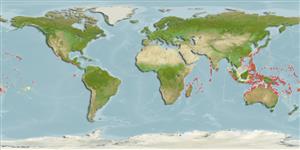Actinopterygii (ray-finned fishes) >
Perciformes (Perch-likes) >
Labridae (Wrasses) > Cheilininae
Etymology: Cymolutes: Greek, kymo = waves + Greek, lytes, lyto = to liberate.
Environment / Climate / Range
Ecology
Marine; reef-associated; depth range 2 - 20 m (Ref. 37816), usually 6 - ? m (Ref. 48636). Tropical, preferred ?; 32°N - 32°S
Indo-Pacific: East Africa to New Britain and the Marquesan (?) Islands, north to southern Japan, south to Lord Howe Island.
Size / Weight / Age
Maturity: Lm ? range ? - ? cm
Max length : 20.0 cm TL male/unsexed; (Ref. 48636)
Dorsal
spines
(total): 9;
Dorsal
soft rays
(total): 9-12;
Anal
spines: 2-3;
Anal
soft rays: 9 - 12. Differs from C. praetextatus by having 12 instead of 13 dorsal rays, dark brown markings on the head and body, and lacking the small black spot on the upper base of the caudal fin (Ref. 1602).
A solitary species (Ref. 90102) common over sandy areas of reef flats and shallow sandy lagoons to a depth of at least 6 m. Also found in estuaries. Feeds on benthic invertebrates (Ref. 89972). Usually in current zones such as tidal channels. Juveniles often with small outcrops of rubble and algae or around the edges of sparse seagrasses (Ref. 48636). The species is capable of diving into sand when threatened.
Life cycle and mating behavior
Maturity | Reproduction | Spawning | Eggs | Fecundity | Larvae
Oviparous, distinct pairing during breeding (Ref. 205).
Randall, J.E., G.R. Allen and R.C. Steene, 1990. Fishes of the Great Barrier Reef and Coral Sea. University of Hawaii Press, Honolulu, Hawaii. 506 p. (Ref. 2334)
IUCN Red List Status (Ref. 115185)
CITES (Ref. 94142)
Not Evaluated
Threat to humans
Harmless
Human uses
More information
ReferencesAquacultureAquaculture profileStrainsGeneticsAllele frequenciesHeritabilityDiseasesProcessingMass conversion
Tools
Special reports
Download XML
Internet sources
